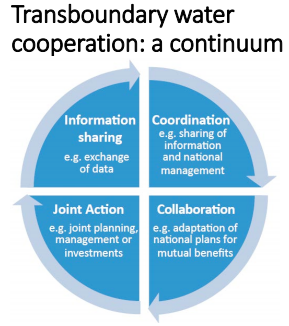International River Governance
This article is based on “China’s Brahmaputra dam: Trans-boundary water governance in South Asia needs a rethink” which was published in The Down to Earth on 18/12/2020. It talks about the issues related to Trans-Boundary river governance.
In recent times, there are many reports of China building dams on the Brahmaputra river, close to the Line of Actual Control in Tibet. The move could have a far-reaching impact on water security in India’s North East.
The major rivers that drain South Asian states, the Indus, the Brahmaputra and many of the midstream tributaries of the Ganga originate in Tibet.
This transboundary nature of major rivers and China being an upper riparian state has a clear advantage in building dams and other infrastructure to reduce or divert water flow from river systems originating in Tibet.
As the whole of South Asia comes under ‘high’ to ‘extremely high’ water-stressed areas, the establishment of trans-boundary rivers cooperation is the need of the hour.
Significance of Trans-Boundary River Cooperation
- Linkage With Climate Change: Transboundary water cooperation offers opportunities to realize and capitalise on the wider benefits e.g. strengthen resilience to climate change and prevent and resolve conflicts over water resources.
- Moreover, building dams in the Himalayan region will result in emerging risks like extreme events (floods, droughts), landslides, forest fires and many other ecological threats pose new governance challenges.
- Linkage With SDG: Recognition of the importance of transboundary cooperation is a prerequisite for realising the water-related SDG targets and the broader Sustainable Development Goals.
- Target 6.5: By 2030, implement integrated water resources management at all levels, including through transboundary cooperation as appropriate.
- Linkage With Regional Development: As international waters can be catalytic agents, transboundary water cooperation has often resulted in improved wider economic integration between riparian states.
- Transboundary water cooperation can, directly or indirectly, act as a catalyst to improve international trade, economic development, navigation, energy generation, wildlife conservation, and broader regional integration.
- Transboundary water cooperation arrangements also facilitate investments by providing a stable and reliable legal and institutional environment for investors.
Associated Challenges
- Natural Advantage: Dams or water diversion projects in the upstream areas of rivers have a significant effect on downstream flows. Communities in the lower riparian areas have to accept what is being offered to them.
- Neglect of International Law: Even though there is an international convention regarding the trans-boundary river governance, there is a lack of a cooperative framework for managing river systems in South Asia.
- Moreover, around 60% of transboundary river basins worldwide still lack any cooperative arrangement.
- In addition, existing transboundary water treaties and institutions are often weak in terms of their mandate, design, resources, and enforcement mechanisms.
Existing Legal Framework on Trans-boundary Rivers
- Convention on the Law of Non-Navigational Uses of International Watercourses, 1997
- Helsinki Convention on the protection and use of Transboundary Watercourses and International Lakes, 1992
- Lack of Trust: The real issue for developing trans-boundary river governance, is not the scarcity of water resources, but the scarcity of ‘social resources’ and abundance of ‘power disparities’ between China and South Asian countries.
- Long-term, Evolving Process: Given the dependence on these collective on water resources, coming to a consensus may take longer negotiations and even a small political tussle can derail development of cooperation framework.
Way Forward
- Water Diplomacy: Trans-boundary river governance can be adopted by the exercise of water diplomacy.
- Water diplomacy is a process which operates under the authority of sovereign national governments, but which also unlocks cooperation among multiple stakeholders, including at the level of municipalities and states.
- River basin management: Rather than treating rivers from the lens of political borders, there is a need to adopt a river basin management approach.
- This approach respects the integrity of the landscape and the catchments.
- Setting-up Institutional Framework: Agreements and institutional arrangements, such as river basin organizations, can offer an important means to manage transboundary waters in an equitable and sustainable way
- A trans-boundary river governance framework should, share water in river basins and aquifers, pursue legal frameworks for international cooperation, and establish joint institutions for transboundary water governance.
- Apart from this, there is a need for the adoption of common standards for water data collection, sharing, and analysis on transboundary waters.
Conclusion
Disasters and climate impacts do not stop at borders and already about two billion people are living in water-stressed areas. In this context, without transboundary water cooperation, inclusive sustainable development is severely curtailed, and risks to peace and security increased.
|
Drishti Mains Question Without transboundary water cooperation, inclusive sustainable development is severely curtailed, and risks to peace and security increased. Discuss. |

